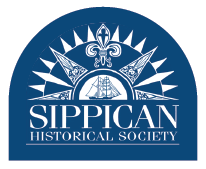 As one of Marion’s most prominent turn-of-the-century summer visitors, Cecil Clark Davis (1877-1955) needs almost no introduction. Her prolific and prize-winning body of work (over 500 oil paintings) is well-known to our community; portraits of such luminaries as explorer Roald Amundsen and aviator Charles Lindbergh, as well as those of Marion friends and family are displayed at the Marion Music Hall, the Marion Art Center, and here at the Sippican Historical Society. Virtually any literature about the history of Marion includes biographical information about Cecil Clark Davis, usually garnished with anecdotes that illustrate her bold, high-spirited personality (she shocked people by appearing in public without hat or gloves!) and her abiding love of dogs. The image above is her early 20th century “Self-Portrait with Her Dog;” at one time, she apparently owned 35 dogs of various breeds, although her favorite was a bulldog who accompanied her on her world travels. A wealth of information exists about Davis, but in the archives of the Sippican Historical Society, there is always more to be discovered.
As one of Marion’s most prominent turn-of-the-century summer visitors, Cecil Clark Davis (1877-1955) needs almost no introduction. Her prolific and prize-winning body of work (over 500 oil paintings) is well-known to our community; portraits of such luminaries as explorer Roald Amundsen and aviator Charles Lindbergh, as well as those of Marion friends and family are displayed at the Marion Music Hall, the Marion Art Center, and here at the Sippican Historical Society. Virtually any literature about the history of Marion includes biographical information about Cecil Clark Davis, usually garnished with anecdotes that illustrate her bold, high-spirited personality (she shocked people by appearing in public without hat or gloves!) and her abiding love of dogs. The image above is her early 20th century “Self-Portrait with Her Dog;” at one time, she apparently owned 35 dogs of various breeds, although her favorite was a bulldog who accompanied her on her world travels. A wealth of information exists about Davis, but in the archives of the Sippican Historical Society, there is always more to be discovered.
The Sippican Historical Society was founded in 1963 “for the purpose of fostering interest in the town of Marion, encouraging historical research and writing, and establishing a museum to preserve and display artifacts, documents and artwork pertaining to the town.” One of the collections currently being archived at the SHS is held in two rather ordinary-looking blue and white plastic file boxes that we received in 2012 from a donor in Naples, Florida. He had no use for them, as they had belonged to his recently deceased wife, Carol Cain Farrington. The boxes are full of Farrington’s research notes on Cecil Clark Davis; she had intended to write Davis’s biography, but passed away before even beginning it. The notes are well-organized, labeled, annotated, and appear to be quite comprehensive, treating such subjects as Davis’s education, travels in the Congo with her husband Richard Harding Davis, her many friends and associates, and of course, her love of dogs. Also included in the collection are Davis’s hand-written journal entries dating from 1907 through 1933, as well as many of Farrington’s own notes and research ideas, and even her intended book proposal. A preliminary survey of the collection suggests evidence of serious research, and may perhaps provide some new information about one of Marion’s most captivating summer residents.
The SHS recently received a generous donation of 35 of Davis’s “extremely significant” oil paintings on permanent loan from Tabor Academy, which will enable the public to view many of these works in a rotating exhibit, and learn about this talented, strong-willed and independent American artist. Perhaps some curious writer/researcher will help us discover even more about the life of Cecil Clark Davis through Farrington’s fully accessible, certainly interesting, and possibly revelatory research notes and files preserved in our archives.
